
- Home
- India
- World
- Premium
- THE FEDERAL SPECIAL
- Analysis
- States
- Perspective
- Videos
- Sports
- Education
- Entertainment
- Elections
- Features
- Health
- Business
- Series
- In memoriam: Sheikh Mujibur Rahman
- Bishnoi's Men
- NEET TANGLE
- Economy Series
- Earth Day
- Kashmir’s Frozen Turbulence
- India@75
- The legend of Ramjanmabhoomi
- Liberalisation@30
- How to tame a dragon
- Celebrating biodiversity
- Farm Matters
- 50 days of solitude
- Bringing Migrants Home
- Budget 2020
- Jharkhand Votes
- The Federal Investigates
- The Federal Impact
- Vanishing Sand
- Gandhi @ 150
- Andhra Today
- Field report
- Operation Gulmarg
- Pandemic @1 Mn in India
- The Federal Year-End
- The Zero Year
- Science
- Brand studio
- Newsletter
- Elections 2024
- Events
How B Jayashree’s Spandana has kept folk theatre thriving for half-a-century
On October 11-12, an old tale came to life in all its colours and grandeur in Karnataka. King Krishna waged a war against Indra, who refused to give him the Parijata tree, which the former wanted to mollify one of his eight wives, Satyabhama. Legend has it that Satyabhama had expressed her displeasure to Krishna after he gifted Parijata flowers, known for their fragrance, to his other...
On October 11-12, an old tale came to life in all its colours and grandeur in Karnataka. King Krishna waged a war against Indra, who refused to give him the Parijata tree, which the former wanted to mollify one of his eight wives, Satyabhama. Legend has it that Satyabhama had expressed her displeasure to Krishna after he gifted Parijata flowers, known for their fragrance, to his other wife Rukmini. To pacify Satyabhama, Krishna asked Indra to give him the tree which grew only in the latter’s abode, Indra Lok. When Indra refused, a war ensued.
The mythological story has been told in theatres across India over centuries, trying to explore why Krishna fought Indra when the former had himself given life to the latter. The popular incident from Mahabharata is performed as Sri Krishna Parijata in the Sannata form, a folk theatre form in Karnataka. The same story is performed as Parijat Haran in Assam in the Sattriya form, a classical dance form.
But in October, at Ranga Shankara in Bengaluru’s JP Nagar, the play performed by Spandana Theatre, an amateur theatre company, turned the lens on the story of Parijata itself against the backdrop of the Krishna-Indra war.
It is these freshness-infusing tweaks to the narration of folk tales that have set Spandana apart from the league and helped it thrive over 50 years, a time span which saw the demise of many amateur theatre companies.
Hundreds of theatre troupes that were founded in Karnataka during the pre-Emergency period have suspended their activities over one reason or the other. Only a few such as Ranga Sampada, Samudaya, Benaka (Bengaluru Nagara Kalavidaru) are attracting theatre lovers to auditoriums. Spandana, being run by acclaimed artist B Jayashree, is one among the thriving theatre troupes in Kannada amateur theatre league. The play Sri Krishna Parijata is being staged as part of the celebrations of Spandana completing 50 glorious years of existence.
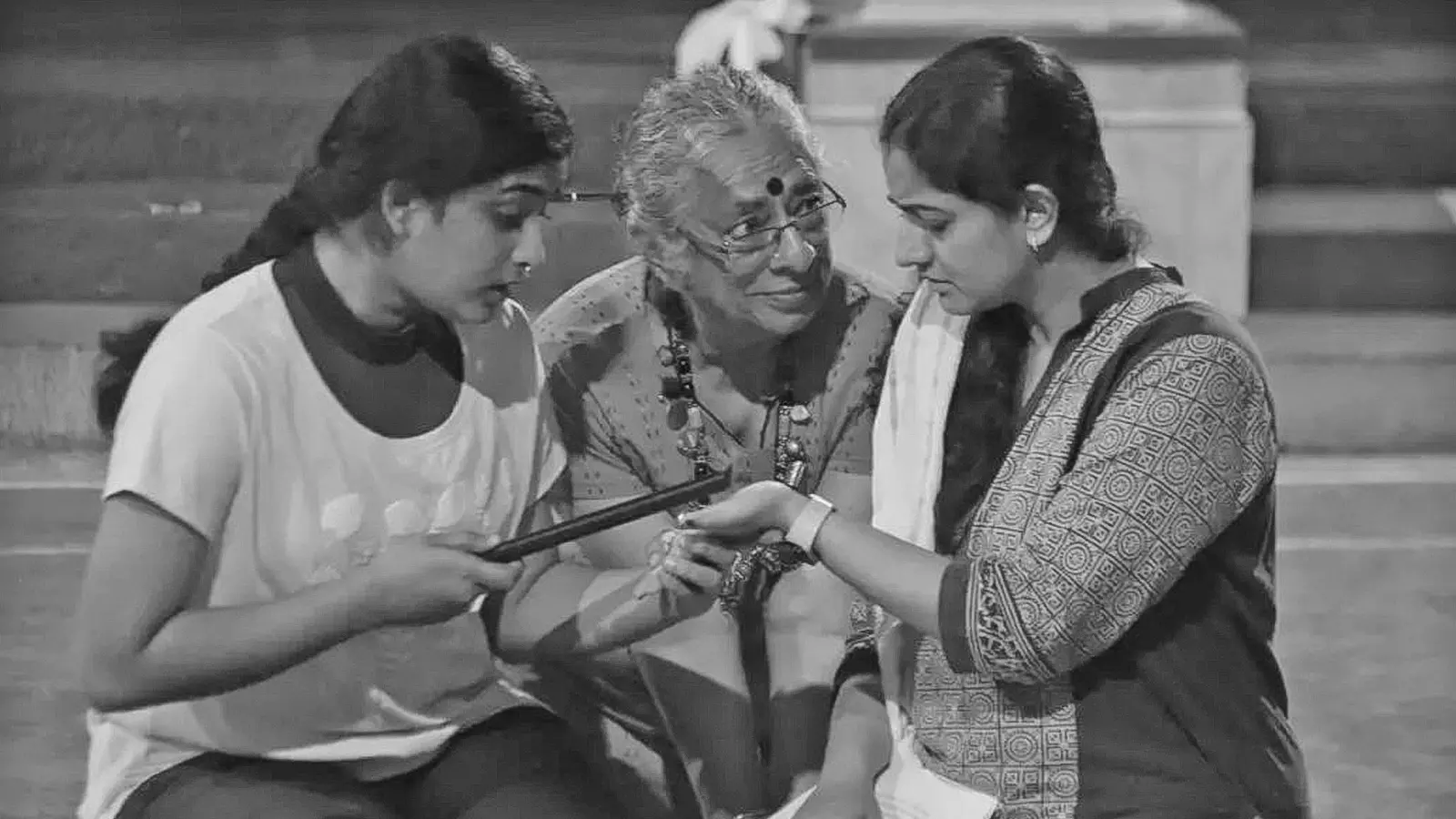
B Jayashree ensures artists joining Spandana singing and dancing, besides acting. Photo: Facebook
Jayashree is a major reason for the success of Spandana. Actor, theatre director, singer, and recipient of Padma Shri, besides being the granddaughter of Gubbi Veeranna, doyen of Kannada theatre and cinema, Jayashree has infused in theatre a blend of the modern and traditional, making it relevant for both the young and the old.
Seventy-three-year-old Jayashree, who has an ‘umbilical cord’ relation with professional company theatre, popularly known as Nataka Company in Karnataka, introduced a new energy to amateur theatre by incorporating folk and native cultural traditions while telling mythological tales.
Theatre for Jayashree is all about connection and she has turned Spandana into a platform to keep alive stories of the land through the ancient oral tradition of storytelling and music.
Towards that cause, Jayashree incorporated various folk art forms, including Kinnari Jogera Ta, Bayalaa Ta, Bhoothera Ta, Gondaligara MeLa, and Veeragase into plays produced by Spandana. To ensure a continuity with Nataka Company, Jayashree asks the artists at Spandana to learn singing and dancing, besides acting, which are quintessential requirements of the company.
Sri Krishna Parijata is being staged by Spandana in the Sannata form, which follows a musical structure, a folk theatre form in Karnataka. Sannata also known as Dappinata, as against the DoDData, which is a serious dignified and upright form, evolved to give expression to rasas such as Shrungara, Karuna, Hasya and the six emotions of sadness, happiness, fear, anger, surprise and disgust. Sannata also tries to interpret Vedantic philosophy in a simple way ensuring the audience doesn’t lose interest. Despite having elements of Sannata folk art forms, the play breaks stereotypes.
“Many folk teams have staged Sri Krishna Parijata in Sannata form in north Karnataka. It is Parijata Haran in Assam, and Bhama Kalap in Andhra Pradesh and Telangana. All the performances are in folk style. The challenge was to stage Parijata for the amateur theatre in the form of Sannata and make the audience watch the play till the end, without being bored. We have offered importance to dialogues and music, which are quintessential characteristics of Sannata. After Narayanaswamy handed over the draft of the play, we changed it seven times and included dialogues wherever necessary with the permission of the playwright,” Jayashree told The Federal.
Like every play B Jayashree directs, Parijata also has a folk element in it. Keeping in mind proscenium and open-air theatres, Jayashree structured the play within an 18-feet long and 12-feet wide area.
Since in the Sannata format, there aren’t more than two actors and one musician on the stage, Jayashree introduced close to 20 actors, and restricted each scene to three artistes. Despite having elements of folk art form and characteristics of company theatre in Parijata, Jayashree hasn’t stereotyped the characters.
The play received rave reviews and got Parijata included in the list of Jayashree’s most successful plays, which includes Karimayi, Sadarame, Neevu Kaanire, Lakshapathi Rajana Kathe, Chitrapata Ramayana, Ghasiram Kotwal, Nagamandala, and Sirisampige.
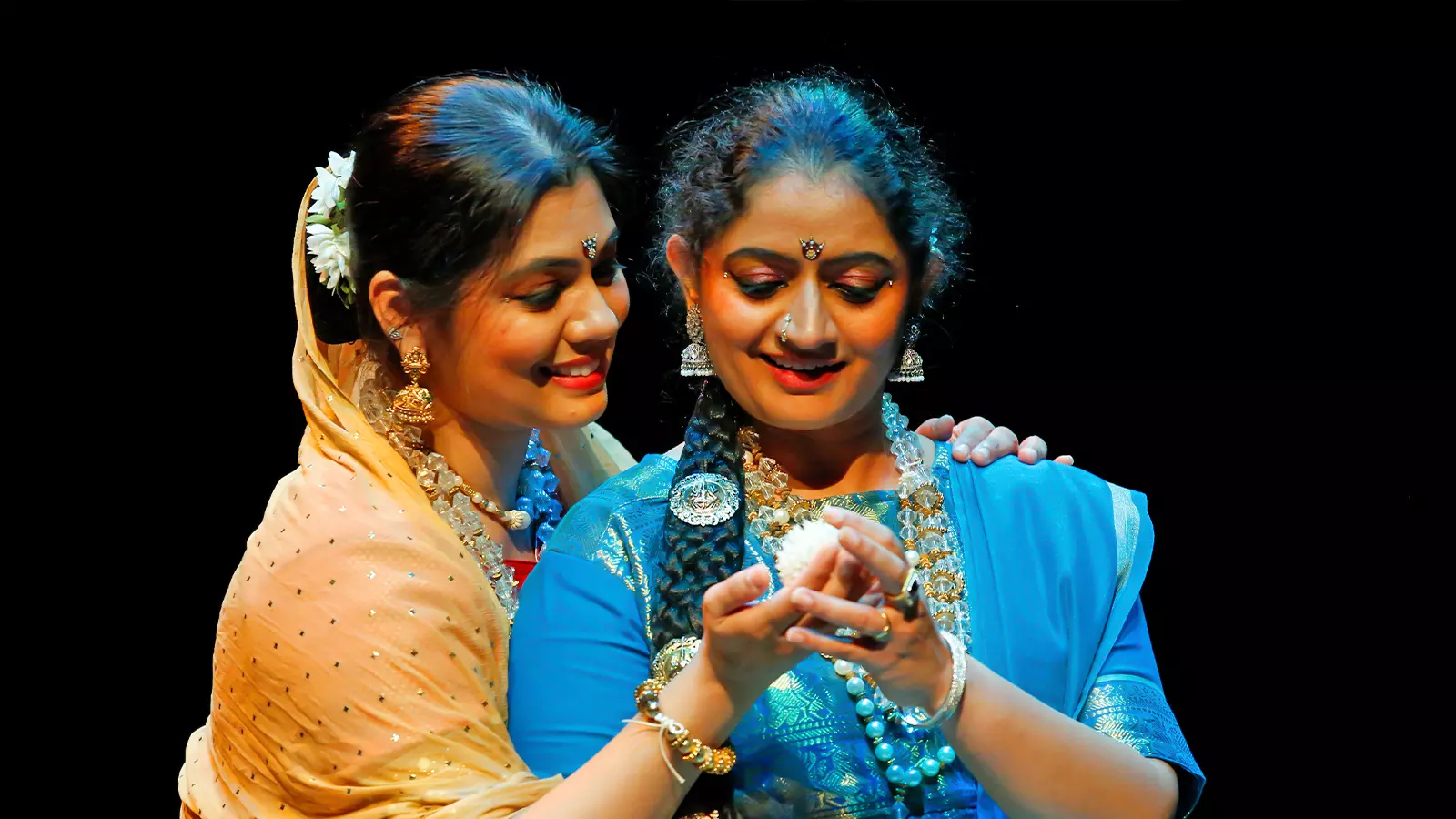
A scene from Sri Krishna Parijata staged by Spandana.
“Jayashree’s strength lies in a proportionate blending of the old and new scripts, besides offering nuanced elements of folk theatre,” said Preethi Nagaraj, writer of Kanna Muchhe…Kaade Goode.., Jayashree’s biography.
In fact, Kanna Muchhe Kaade Goode… is a nursery rhyme, which kids used to recite while playing hide and seek in Karnataka. It is probably used as a metaphor for life at play in the book’s title.
“She is a woman of craft and creativity, who can blend old scripts with new ones in measured proportion without allowing a heavy flow of nostalgic moorings. The way she offers modern insights in old scripts is truly amazing. Jayashree excels in it. She found that perfect balance because of her professional theatre background and her academic study at National School of Drama,” says Preethi Nagaraj, who too is a theatre practitioner and a close associate of Jayashree.
Contrary to perception, though Spandana has been nurtured by Jayashree, she isn’t its founder.
“Jayashree joined the theatre group at the fag end of the Emergency in 1976, breathing a new life into Spandana and getting the troupe national and international recognition,” says Anandraj, who is a founder member of Spandana.
The first play she directed was Vijay Tendulkar’s Ghashiram Kotwal.
Spandana actually started with Rangashree, headquartered in Chikkamagaluru, founded by Satyasandha and his friends. “It was Anandraj and Rani Rao who brought the troupe to Bengaluru and renamed it Spandana,” says Sarvesh, Spandana’s treasurer for the past 40-plus years.
Spandana has produced over 75 plays and offered a new dimension to Kannada theatre, along with other troupes of its league.
Lakshapathi Rajana Kathe, for instance, has seen more than 700 shows staged by Spandana both in India and abroad. The theatre group’s plays have also been staged during theatre festivals in Russia and Egypt.
Based on the work of Jnanpith Award recipient writer Chandrashekara Kambara, Jayashree interspersed engaging anecdotes with full-throated and spirited renditions of folk songs in the works of Spandana.
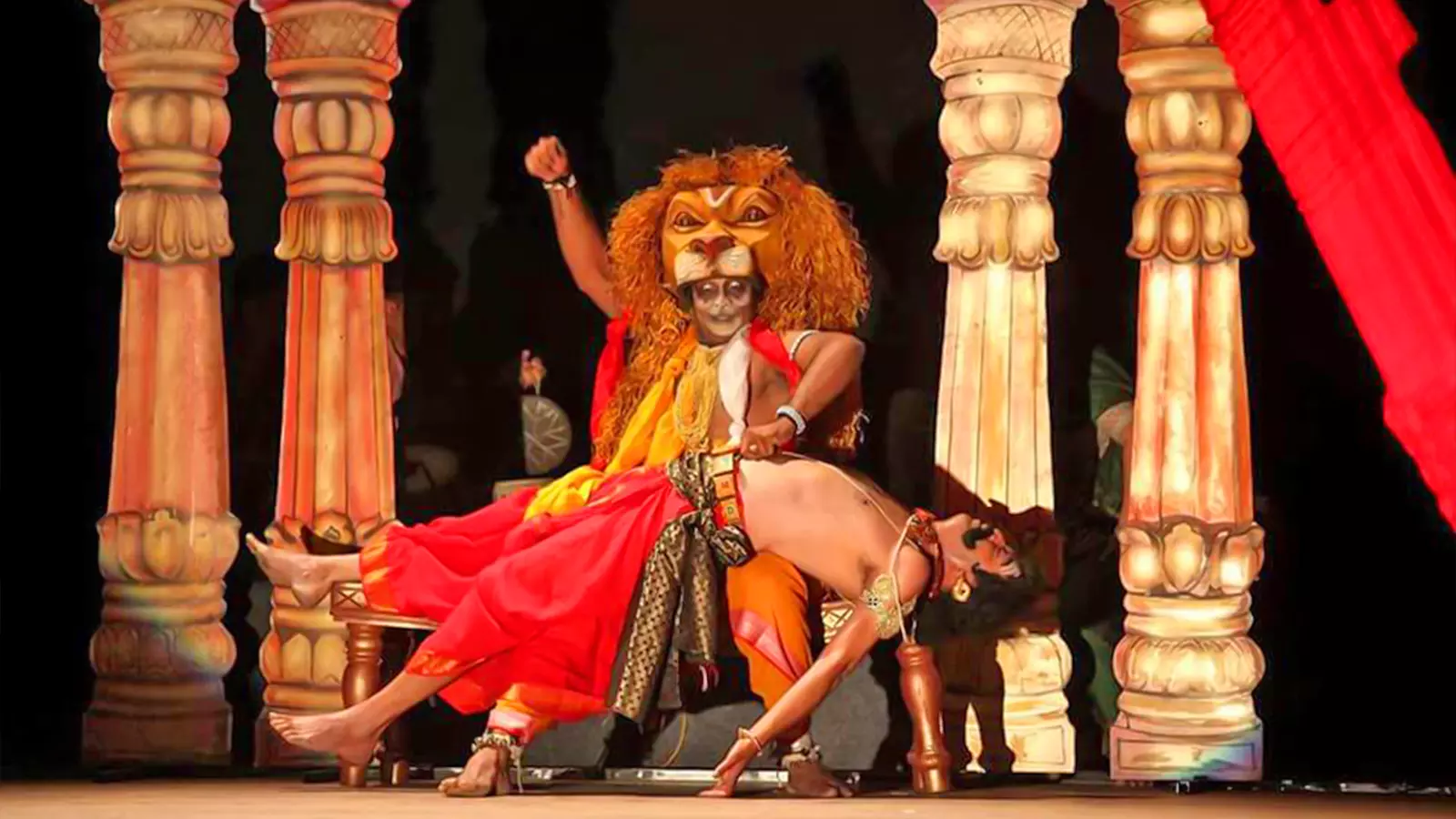
Scene from a play staged by Spandana, which has been telling folk tales, connecting Nataka Company to amateur theatre.
It is an unforgettable performance for the audience, when they hear the invocation song “Sri Ganaraya…”. in the Kinnari Jogerata (a famous folk form of north Karnataka) style.
Similarly, Karimayi saw more than 500 shows. It is one of the Kannada theatre’s longest-running plays. The play in itself is a feast for music lovers as its music has been composed by Chandrashekara Kambara. The live original music and singing are led by B Jayashree.
When Jayashree renders the title song of Kambara’s novel Karimayi Savirada Sharanavva Karimayi Thaye…, which was adapted to the stage, the audience is left spellbound.
“It is an electrifying performance by Jayashree and the audience is enthralled by Jayashree’s voice, accompanied by vocalists and musicians on folk drums. Had they not watched the performance, no one would have believed, a septuagenarian is singing it,” Sarvesh recounts.
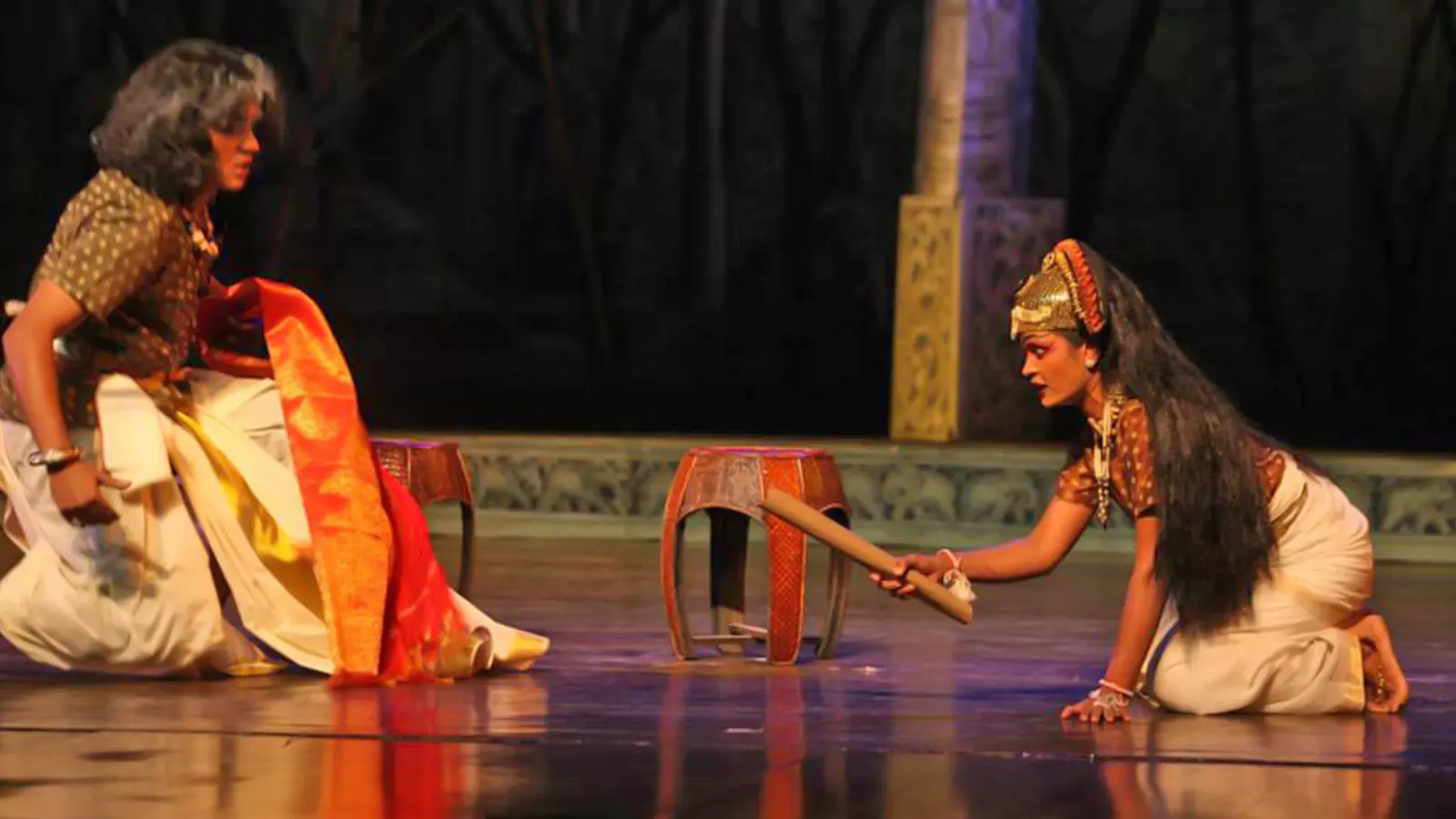
Spandana actually started with Rangashree, headquartered in Chikkamagaluru, founded by Satyasandha and his friends.
8Jayashree likes to take up challenging scripts.
For instance, Girija Kalyana written by B Suresh deals with many layered issues projecting which on stage can be an intimidating task. Though the play’s theme is set against a rural background, it raises various contemporary issues such as farmers’ suicide, fascination of cinema in rural Karnataka and insensitivity of the media among other things. Jayashree offers a touch of traditional folk style with a dash of naturalism. Her production goes further to expose middlemen and sex hungry politicians, who rob Girija, an innocent dreamy village girl, off whatever little she had.
Because of her professional theatre training, Jayashree excels in making theatre an audience-delight.
“She is a natural talent. It was NSD which honed her talent to suit the greater needs of theatre. She got trained under illustrious personalities like Ebrahim Alkaji, BV Karanth, NS Venkataraman and others. The NSD background helped Jayashree to direct plays in Kannada, English, Hindi. Kannada cinema has also used her acting and singing prowess,” says Girish Karnad in the preface to Kanna Muchhe…Kaade Goode.
Trained in professional company theatre, she learnt the nuances of singing and acting when she faced the need for it.
“I first met BV Karanth, when I was just seven years old at Gubbi theatre. When I was confused about structuring Lakshapathi Rajana Kathe in terms of concepts, I shared my confusion with Karanthanna. He told me, ‘You fasten whatever comes to your mind. Don’t hesitate. You will find the way on your own. His words instilled confidence in me and Lakshapathi Rajana Kathe remains a legendary experience for me,” recalled Jayashree.
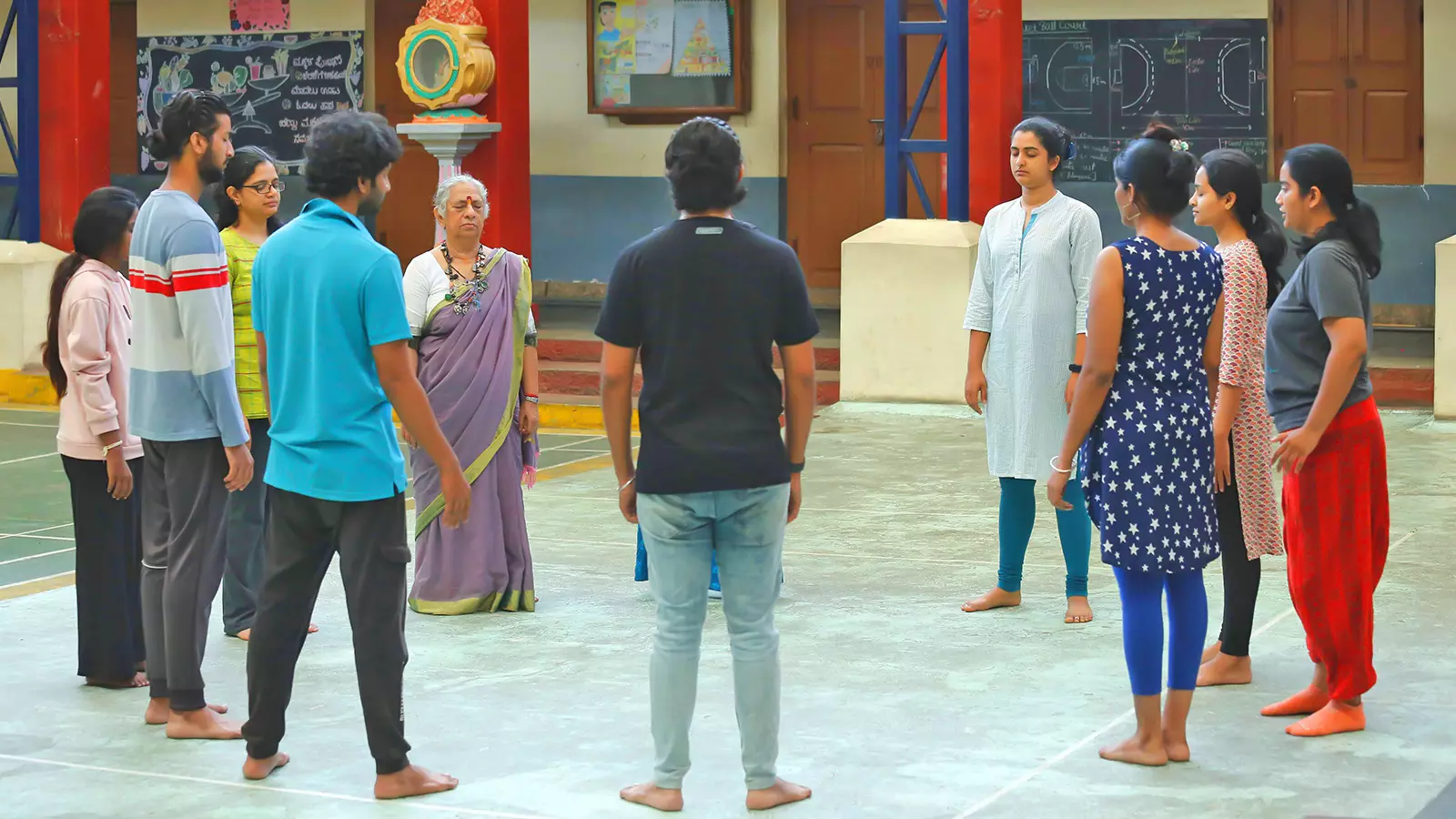
B Jayashree with artists of Spandana.
“I learnt how to transform disability to ability from Balakrishna (renowned actor in Kannada cinema). Similarly, legendary P Kalinga Rao, (famous light music exponent) taught me the ways to sing by experiencing the emotions. Most importantly, I learnt voice throwing from Amma,” she says.
Given her training at Gubbi Company, which was the first company in Karnataka to employ female artistes to portray female characters, Jayashree managed tonot just survive, but thrive in a field dominated by men.
“Jayashree is a beneficiary of feminism, which started shaking shape in India in mid-19th century. She proved her mettle in a creative space that was had only men. She survived on her merit. It is not easy to survive in theatre for long because it was never, and is still not a great option for making money,” said Preethi Nagaraj.

